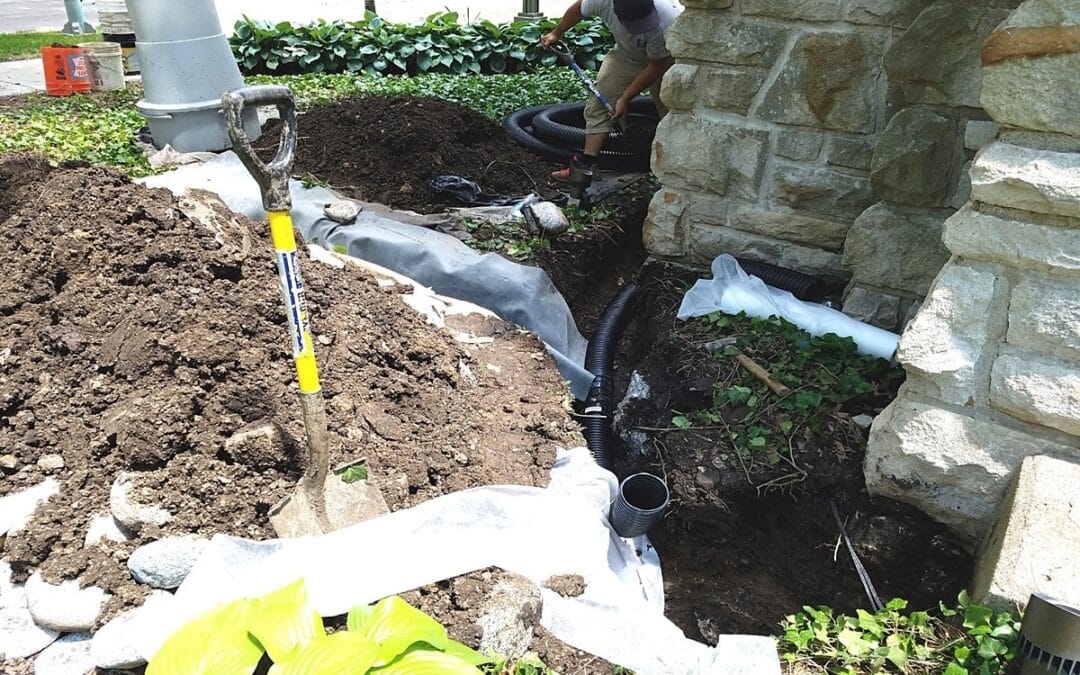If rainwater stays in your yard or your basement smells bad, your home might have a drainage problem. A storm water drainage system helps move water away so it doesn’t cause damage.
Without good drainage, water can soak into the ground near your house. This can lead to mold, wall cracks, and costly repairs. A strong system keeps your home dry and safe.
What is a Storm Water Drainage System?
A storm water drainage system moves rainwater and melted snow away from your property. This helps prevent water from pooling around your home or seeping into places it shouldn’t.
Key Parts of a Drainage System
Most homes use a mix of:
- Gutters and downspouts
- Grading (the slope of your yard)
- French drains or trench drains
- Catch basins
- Sump pumps
- Underground pipes
Residential vs. Municipal Drainage
Municipal systems handle water from roads, sidewalks, and neighborhoods. These systems use storm drains to send runoff to streams or treatment plants. Residential drainage systems are smaller and designed to protect individual homes. They connect with city systems but focus on your yard, roof, and foundation.
Why Storm Water Drainage Matters for Your Home
1. Protects Your Foundation from Water Damage
When water collects near your foundation, it can weaken the concrete or cause cracks over time.
2. Prevents Basement Flooding and Mold Growth
If water leaks inside, your basement can flood or develop mold, which can lead to health problems.
3. Helps Manage Heavy Rain and Snow Melt
A working drainage system helps prevent water from pooling in your yard or driveway during storms.
4. Reduces Soil Erosion Around Your Home
When water moves too quickly across bare soil, it can wash away dirt and landscaping. Good drainage keeps things in place.
Common Types of Stormwater Drainage Solutions
Surface Drainage Systems
These remove water across the top of your yard. Common types include:
- Grading: Sloping the ground away from the home
- Swales: Shallow, grass-covered channels
- Ditches: Deeper channels that carry water away
Subsurface Drainage Systems
These work underground to move water that seeps into the soil:
- French drains: Gravel-filled trenches with a pipe
- Drain tiles: Pipes installed along foundation walls
Downspout Extensions and Splash Blocks
These direct roof runoff several feet away from the house so it doesn’t collect at the base.
Catch Basins and Yard Drains
These collect surface water in low areas and route it to underground piping.
Sump Pumps with Discharge Lines
Installed inside the home to pump groundwater out of a sump pit and away from the foundation.
Stormwater Management Techniques for Homeowners
Proper Gutter and Downspout Maintenance
Clean gutters twice a year and make sure downspouts direct water at least 6 feet away from the house.
Grading Your Yard Away from the Home
We recommend a slope of 5% (or about 6 inches per 10 feet) away from the foundation.
Installing French Drains or Trench Drains
These help collect water in wet spots and move it underground to a safe area.
Rain Gardens and Permeable Surfaces for Yard Drainage
Rain gardens and porous pavers let water soak into the ground instead of running off.
Using Retention or Detention Basins in Large Properties
These are small ponds that hold water temporarily or permanently, especially useful for large backyards or sloped lots.
How Poor Drainage Leads to Foundation Issues
Bad drainage can cause serious problems around your home:
- Water Pressure: When too much water builds up in the soil, it pushes against your basement walls and can make them crack.
- Frozen Ground in Winter: Water in the soil can freeze and grow bigger. This can lift concrete and hurt your foundation.
- Soil Moving: Wet soil can grow, and dry soil can shrink. This can make your foundation shift or crack.
- Water Leaks at the Bottom: Water can leak through small cracks near the base of your home. This can weaken the structure and cause mold or bugs.
Why Routine Drainage Inspections Are Important
When to Inspect
- After major storms
- At the start and end of each season
- Before or after major landscaping or home projects
Who Should Inspect
A professional drainage or foundation expert who understands both water movement and structural impact.
What to Check
- Clogged pipes or basins
- Standing water
- Yard slope
- Cracks in walls or concrete
How We Help with Stormwater Drainage at Foundation 1
We offer drainage solutions that fit your yard and protect your foundation. Our team installs:
- Surface and underground drains
- French drain systems
- Downspout extensions
- Sump pump discharge lines
- Waterproofing and crack repair if there’s damage
If your home has a storm water drainage problem, we can fix it and help stop it from happening again.
Conclusion
Rainwater may not look like a big problem, but without good drainage, it can hurt your foundation. A working system helps protect your home, saves money, and keeps your basement dry. If you see standing water or cracks, call Foundation 1 for an inspection. We’ll check your storm water drainage system and explain what needs to be done.

